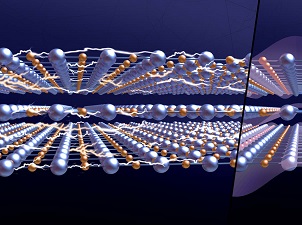On Science a result in the quest of room temperature superconductors, materials that might revolutionize technologies by lowering energetic costs of electricity distribution and change the way electricity is produced and delivered across the world. In fact, the study improves our understanding of the “strange” behavior of cuprates, superconducting materials made of copper, oxygen and other elements, which work as superconductors only at very low temperatures (although higher than for other superconductors). Improving these materials, i.e. increasing their critical temperature, would lead to a true technological revolution.
Scientists of Chalmers University in Gothenburg, Politecnico di Milano, Sapienza University in Rome and the European Synchrotron ESRF in Grenoble have discovered that, in the normal state at “high” temperature, the presence of charge density waves modifies the charge transport properties of cuprates, from that of a “strange metal” to a more common behavior of other metals.
Electric current travels without resistance inside superconductors kept at temperatures smaller than a critical value. In that, they are different from normal metals, where resistance entails the production of heat, and thus a waste of energy, whenever a current is flowing. Although known by more than a century, superconductivity remains one of the most fascinating and mysterious phenomena in the physics of solids. Since the initial discovery, the main objective has been the search for materials that are superconductor at ambient temperatures, so to enable they massive utilization. In that quest cuprates are special, because their critical temperature is less low than that of other known superconductors. Moreover, the reasons for this special behavior are still unclear.
One important property of cuprates is that, even at temperatures larger than the critical one, in their “normal” state, where their resistance is not zero, they behave in a non-conventional way, so that they are told to be “strange metals”. The strangeness is in the linear increase of the resistivity versus temperature, which is not observed in normal metals. Understanding the microscopic origin of this strangeness of the normal state of cuprates is one of the main objectives of the current scientific research in this field.
Prof. Giacomo Ghiringhelli, of the Politecnico di Milano explains: “This type of observation is very relevant because we have eventually found a correlation between a macroscopic property (resistivity in the normal state) and a microscopic one (charge density waves). This might be the long-sought key for theoreticians to formulate the explanation of such an unconventional behavior of cuprate superconductors”.
To fully understand the importance of this work, one has to consider that superconductivity is the most spectacular macroscopic manifestation, visible to the naked eye, of quantum physics, which is always needed to describe the phenomena at the atomic scale, but usually not at the macroscale. Superconductivity is a macroscopic quantum phenomenon. Now we know that even at relatively high temperatures, in their “normal” state, cuprates show a quantum behavior, for which we can talk of “ultra-quantum matter”.


